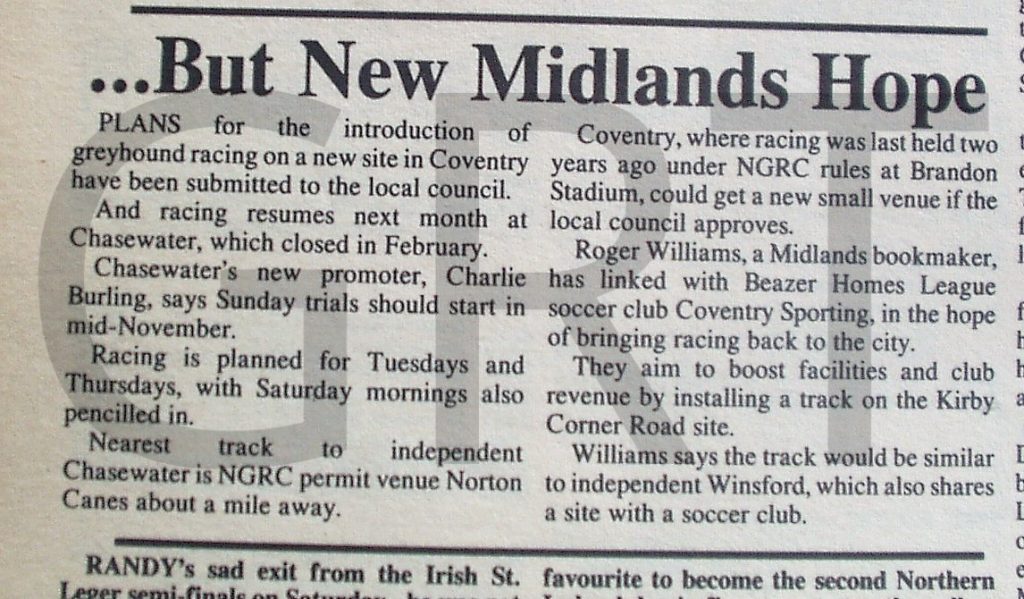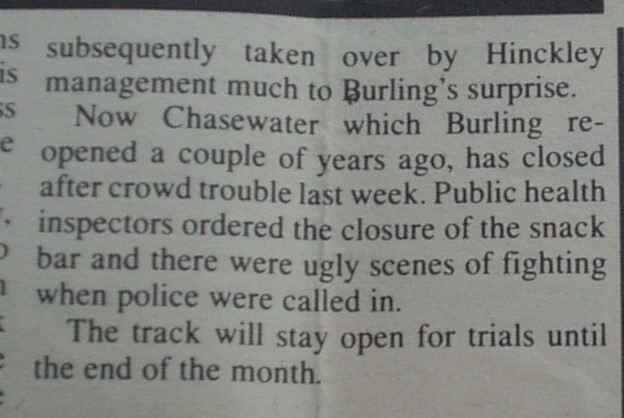Chasewater Stadium, Pool Road, Brownhills, Staffordshire.
POSTCODE———————————-WS8 7NL
LOCATED————————————-Just south of the M6 Toll Road north of the A5 on Pool Road one mile north of the town of Brownhills.
ORIGINAL SITE——————————Land owned by a Mining Company.
DATE CONSTRUCTED——————–1971
DATE VENUE OPENED——————-1971 for Harness Racing.
Meaning other sports may have taken place prior to the arrival of Greyhound Racing.
FIRST MEETING—————————-July 24th 1981.
Greyhound Racing only.
LICENSED OR INDEPENDENT———-Independent.
All venues covered would have to be licensed with the government, licensed suggested in this section would refer to tracks operating under NGRC Rules.
INSIDE OR OUTSIDE HARE TYPE——Inside Sumner for the first year then switched to an outside Sumner from then on.
Please note that the Electric Hare suggested is only a guidance and would have been in operation for a certain amount of time at this venue. Although it is not necessarily guaranteed that it was operational all the time, as other types of lure may have been used and updated as time progressed.
DISTANCES———————————–290,450 and 700 metres.
Please note that most racing venues distances had become varied throughout the years, the ones given above were at once point set and offers only a guidance to the track size.
CIRCUMFERENCE—————————Don’t know.
Please note that alterations at most racing venues throughtout its existence would see that the circumference of the track would vary, the one shown above offers only a guidance to the track size.
BIG RACE NAMES—————————The Chasewater Derby.
STADIUM SHARED WITH——————Harness Racing.
LAST MEETING——————————-Late 1990 or early 1991.
Greyhound Racing only.
STADIUM CLOSURE DATE—————-1991
Meaning other sports may have taken place after Greyhound Racing had ceased.
STADIUM DEMOLITION——————–Main stand demolished during 1998 having suffered serious storm damage.
BUILT ON SITE——————————–Nothing, land left overgrown.
In some cases, structure’s that originally covered the venue after the stadium had been demolished, may have been themselves demolished too, so the one described is more likely to be the one which now presently covers the site.
EVIDENCE LEFT TODAY——————–Satellite views still offer the shape of the greyhound track.
FURTHER COMMENTS———————The main grandstand lay clearly visible from the A5 half a mile away after it had been transported bit by bit one hundred miles from its original home of the Prestatyn Raceway.

Images provided courtesy of Mr G Yates.














One mile north of the Staffordshire town of Brownhills, lies the old site of the Chasewater Trotting Stadium. The location of the old stadium lies sandwiched between the A5 to the south, and the modern M6 Toll Road to the north, with Pool Road running virtually parallel at its western boundary.
The stadium had originally been constructed in 1971 on derelict land once occupied by a mining company owned by J & B Cox of Tipton, with the view of hosting Harness Racing. The site no doubt was huge, capable of holding up to 20,000 spectators, with its focal point being a very impressive glass fronted grandstand, so large that it was clearly visible from the A5 half a mile away. The grandstand had originated from the Prestatyn Raceway in North Wales, which had closed during the late 1960’s, then after being purchased, was transported over one hundred miles all the way to the Chasewater site.
Although Harness Racing had been its main feature, the stadium needed other sports to survive. In April 1977, Speedway made its one and only appearance, that of an international event between Great Britain and The Rest of the World, thus attracting star riders from all corners of the globe. Further Speedway events became non-existent, the reason was that the council objected against the noise, quite surprisingly considering the M6 Toll Road which passes close by, got the thumbs up 25 years later. Other than one Hot Rod event during the 1970’s, no other type of motor sport would ever feature again at the Chasewater venue.
But it was during the first half of 1981, that an all-sanded greyhound track was laid inside the trotting circuit at its southwest corner, in a position still watchable from the grandstand. Trials began on the 27th of June, with the venue opening as a flapping track, and staging its first meeting on the 24th of July 1981. Races consisted of six greyhounds contesting behind an inside Sumner type hare, over distances of 290, 450 and 700 metres.
The following year had seen the greyhound track repositioned; the reason was so to compensate for the installation of an outside Sumner hare, with the start and finishing straight extended and now measured 130 metres long. Although the venue may have seemed impressive to some, its existence was certainly way short of that, as openings and closures of greyhound racing happened too often, same also with changes of management, but its graphical location may have contributed to the lack of punters entering through the turnstiles along with the inadequate numbers of greyhounds available to fill the card.
Another contributory factor to its failure may have been the closeness of the NGRC track at Norton Canes, a greyhound track which lay just one mile northeast of Chasewater, and who had already established itself in the area. More problems arose during January 1988, after a huge storm created so much damage to the grandstand, that the venue remained shut for the next ten months. Another incident in 1989 did not help either, after police had been called in to control an angry crowd after fighting had broken out amongst punters.
Yet it was during 1989 that Harness Racing staged its final event, and by the end of the following year Greyhound Racing had gone too. The future of the stadium looked gloomy, with the site having become unoccupied, it soon drifted into a derelict state, with nature taking its course infesting the site with weeds and shrubs. The glazed viewing area of the old grandstand had become an easy target for vandals, with its interior being stripped of any value by simply those who wanted too.
With the grandstand now becoming nothing more than an eyesore, it was decided to start demolition of the structure in 1998 and by 2000 all outbuildings around the site had gone. What was left of the venue attracted nothing more than horse riders, dog walkers, and bird watchers, with the majority of the land transforming into a mini jungle. Other than an odd few rusty light standard stumps, most of the remnants of the track have now gone, but once again satellite views always seem to unearth that last bit of evidence, with the shape of the greyhound track situated within the trotting circuit still visible at its south westerly point.
Memorabilia for this track is required for this page, if you can help please contact me.

Recent Comments